Your Ultimate Guide to Anime Ending Credits: Part I
by Kevin Cirugeda,There's an understandable disconnect between western anime fans and the craft of their hobby. Anime production is shrouded in mystery, starting with the credits at the end of every TV anime episode; it's not feasible for simulcasts to translate those, and western disc releases don't necessarily pay much attention to them either… and even when they do there's all sorts of issues! The lack of standard terms hurts, but it's especially due to the big differences between western productions (which fans overseas are more used to, even if only passively) and Japanese ones; 絵コンテ are nothing like Hollywood storyboards, and even原画 and key animation have different nuances despite clearly being the same concept. This has led to fans having a very loose understanding of how the process works.
But since we are blessed to live in a Post-Shirobako world where the interest for this sort of thing has increased, let's adventure beyond the cast list at the end of an episode to see what those roles are all about.

-Animation Director (作画監督, Sakuga Kantoku ; 作監, Sakkan):
The people in charge of overseeing the animation within an episode and ensuring its quality and consistency, mostly by correcting the key animation drawings. Since the term could be misleading for people expecting a ‘director’ to have input on creative and management tasks beyond what Sakkans do, it's sometimes referred to as ‘Animation Supervisor’ in western circles. Perhaps not the best terminology since on the Japanese side ‘Animation Director’ is the preferred translation (you might even see the katakana アニメーションディレクター for Chief Sakkans in some Bandai/Sunrise projects), but it does more accurately describe their role.
While their job is to make sure all animated sequences are up to par, they are often thought as the guardians of art uniformity - which is by all means a major aspect of their work, they are a necessary figure to enforce some cohesion to the footage that often has been drawn by dozens of different animators. That doesn't mean, however, that they restrict all idiosyncratic styles for the sake of consistency and sticking to the character designs; many renowned Sakkans allow a rather raw output to come through unfiltered, embracing distinctive drawings if appropriate rather than restricting them. As often unique artists themselves, they value the worth of unconventional animation, and understand that anime's current production model is meant to let a key animator's personal voice be heard to begin with. In fact there's even some Sakkans who, with the permission of the director, pretty much abandon a production's standard designs, temporarily tweaking them into forms they're more comfortable with or feel are more effective.
Being directly responsible for the quality of the animation and often reducing the time to actually animate cuts they might want to handle can make the job a less attractive proposal; sure it is better paid than doing regular key animation, but the extra layers of responsibility and different approach to the craft is not something all pros are fond of. That is why many top animators are not interested in being promoted to Sakkan.
Their corrections (修正, Shuusei) don't necessarily entail fully redrawing the key animation sequence; more often than not they will fix the character's expression and adjust some lines, keeping the foundation of the cut. Chances are that a solid key animator will craft acceptable motion, but nailing designs of a project they might not be very involved with is trickier. This also heavily relies on the Sakkan’s personal approach to the job, the production schedule and the state of the drawings they're mean to supervise so it's hard to generalize about what their role exactly entails.
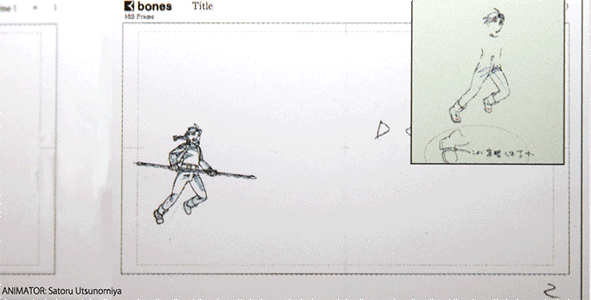
- Chief Animation Director (総作画監督, Sou Sakuga Kantoku ; 総作監, Sou Sakkan ; チーフ作画監督, Chief Sakuga Kantoku):
The overall series animation supervisors, bringing cohesion to the work of all individual Sakkan throughout the series/film. The anime industry's constantly increasing output was never compensated by an equal growth in the pool of available animators, and production schedules gradually got messier. This isn't to say that making anime didn't use to be a stressful endeavor, but having a limited number of staff rushing out a project because they will soon need to work on the next one caused damage. Less time to devote to any given project ironically meant more people required to get it finished with a reasonable level of quality. Ever since the current supervising system was first used in the 60s and for a very long time, having a single Sakkan per episode was enough, but that eventually changed. Being forced to increase their number caused new problems, however; it created the need to oversee the consistency within single episodes handled by multiple people, and more people being involved with the project in general also drastically raised the chances of deviating from the original designs at some point. By supervising the series on an overall level, the Chief Sakkan role is the patch to all these new issues. The work they oversee has already been checked (and hopefully corrected if needed) so it tends to require less effort per cut, allowing them to work on more episodes than a regular Sakkan would.
These extra positions have affected even the tools used to make anime, as different kinds of animation sheets are employed for each layer of supervision; correction forms (修正用紙, shuusei youshi) come in different colors, and while it's not a 100% strictly enforced standard, you can assume yellow/orange ones belong to the Sakkan, while light green is for the Chief Sakkan. You might even see some pink sheets for directors when they have to correct layouts!
For understandable reasons, the Chief Sakkan duty used to end almost always in the hands of the character designer; more than anyone else they're tasked with making sure that characters look like they're supposed to throughout a series, so there's no one better than the person who originally designed them. But at the risk of sounding grim I have to point out that this isn't the case anymore, as it's become sadly common to require multiple Chief Sakkan to ensure an acceptable level of quality. If you're thinking that having multiple artists as the overall consistency supervisors might be counterproductive – congratulations, you found another instance of the anime industry having to choose the lesser evil.
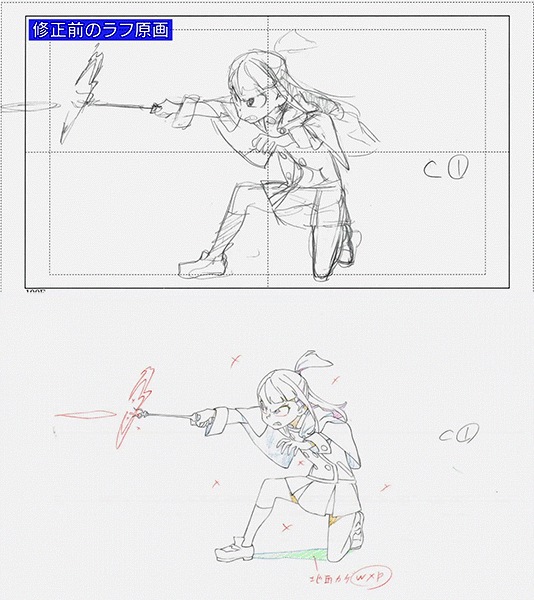
-Specialized Animation Directors – Action Animation Director (アクション作画監督, Action Sakuga Kantoku), Mechanical Animation Director (メカ作画監督, Mecha Sakuga Kantoku), Effects Animation Director (エフェクト作画監督, Effects Sakuga Kantoku) and so on:
Animation directors that exclusively supervise a certain kind of animation within a project. This serves a dual purpose: lessening the workload of the already busy Sakkans, and putting to use specific animation skillsets. The former is self-explanatory, but the latter gives interesting insight – while all animators are supposed to be versatile in their art as they never know what they might have to draw in their new job, certain aspects are tough to master. Such is the case for the oldest instance of this type of role, the Mecha Sakkan; the notoriously solid and volumetric drawings required for robots aren't something everyone can do well (especially not nowadays), so experts on this kind of work are required if you want truly outstanding craft. Even some less specific fields like effects and action have better results when there's a specialist exclusively overseeing them.
Amusing instances of Specialized Sakkan exist on the opposite end of the spectrum as well. A show that regularly deals with one particular kind of scene or theme might assign an animation director to it, even if it doesn't require a precise artistic skillset. Gourmet Girl Graffiti had a Meal Animation Director for its over the top sensual eating, and Yuri Kuma Arashi might have topped every other production by crediting a Bear Animation Director (not to be confused by a trained bear that corrects key animation).
-Assistant Animation Directors (作画監督補佐, Sakuga Kantoku Hosa):
The animation director's helpers, working under them to ensure the work gets finished. Assistant roles are fairly common in TV anime, from storyboard helpers to sub character designers, but Assistant Sakkan is the most prevalent role – unsurprisingly so, since the animation part of anime tends to be the most troublesome. Their appearance isn't always a sign of a panic measure however, since it's also the way to acclimate newbies being promoted within healthier productions. Working alongside someone more experienced (likely their acquaintance) before fully handling an episode by themselves is a regular practice.
It's also worth noting that not only can all the previous Sakkan roles (chief, action, mecha, etc) receive assistants, these terms also sometimes stack to the point of creating (admittedly amusing) monstrosities; a sort of common form is the Key Animation Animation Director Assistant (原画作画監督補佐, Genga Sakuga Kantoku Hosa), but perhaps the most perplexing one was The irregular at magic high school's Chief Chief Animation director (総総作画監督, Sou Sou Sakuga Kantoku). Considering how many Japanese animators laughed and wondered exactly what that credit entailed when the episodes aired, I don't think I can explain it myself.

-Layouts (レイアウト), Layouts Animation Director (レイアウト作画監督, Layout Sakuga Kantoku):
A non-standard credit given to the person who drew the layouts – effectively the blueprints of animation – or was in charge of correcting them, in the case of the Layout Sakkan. Despite this being a credit you won't often see, it's too crucial of a step within anime production to entirely ignore it. Layouts are drawings that translate the information in storyboards (which is limited by format, and can sometimes be rather rough) into the foundation of every shot of an episode. Every small sketch within a storyboard panel is expanded into a full outline of the scene, precisely detailing where the characters will stand, what the camera will do and even notes about filters to use later. This is essential not just for the animation itself but also for the art department, as layouts also depict the background art that will be needed.
Layouts are usually drawn by the animator who has been assigned that cut, but it's not unheard of to have the animation director or a lead animator handle a lot of them. It speaks volumes of the importance of this task that the approval of the director is required to proceed further. Understandably so, since they need to make sure all scenes resemble what they originally envisioned.

-Key Animation (原画, Genga ; 一原, Ichigen):
Not to be confused with the awkwardly namedキーアニメーター title, which refers to a show's main animator. The key animation process consists of drawing the pivotal moments within movement arcs, based off the information in the layouts. Generally that means the very beginning of a cut, the critical poses that define the motion and its end, as well as obviously still shots that require no further work. A key'd sequence is merely a skeleton, but it already allows you to see what the finished scene will be like. This concept is universal and transcends this medium, but each animation school approaches it in a particular manner. Unlike much of classic US work where animation was cast by character or element, virtually all anime scenes are holistically crafted, with a single animator in charge of every element onscreen. This ties into some of anime's quirks; sudden impressive setpieces that feel slightly divorced from an episode's general aesthetic are easier to understand when you realize those scenes were thoroughly conceived by one artist given freedom.
It's also important to understand that the drawings are layered; unlike the layouts where everything present, key animation often handles different elements (like characters and effects) on their own first. Very complex scenes tend to use many layers, and official drawing counts for a project always include them as separate entities.
Ever since the 00s, as the industry dropped cels and transitioned into digital production at large, accusations that anime is no longer hand drawn have become distressfully common. A recrimination that is very off base since the vast majority of animation is still traditionally drawn on paper (which is later scanned), and that is why the announcement that animators’ favorite pencils might stop being produced was enough to send the industry into an uproar. That said however, it's true that the industry is moving towards digital animation – still drawn by hand, but on tablets instead of paper. Youngsters tend to be more used to it and it eases the production (especially when it comes to redrawing), so some studios like Tatsunoko have fully embraced this approach and even try to improve the tech. Digital key animation (credited as such sometimes) has opened up anime to new artistic styles at its best, and is virtually indistinguishable from paper keys at its least fancy. There will always be some artists that stick to traditional means, but by combining both methods anime has improved both as an industry and as an artistic avenue.
There's even information to be inferred from the way the key animators (原画マン, Gengaman) are credited, but sadly the industry's lack of solid standards make it complicated. Alphabetic order, number of cuts animated and chronologic appearance of their work are the most common ways to display them, but often it takes insider information to find out exactly what it was. What's easier to interpret are special credits, sometimes explicit (through titles like Transformation Scene Animation) and others just as a separate set of names. This is a reward for exceptional work, be it a huge amount of drawings or very specific scenes not everyone could manage. A nice practice, but let's not forget that this is the same industry that regularly features uncredited animation for various reasons! Credits are a world of their own.
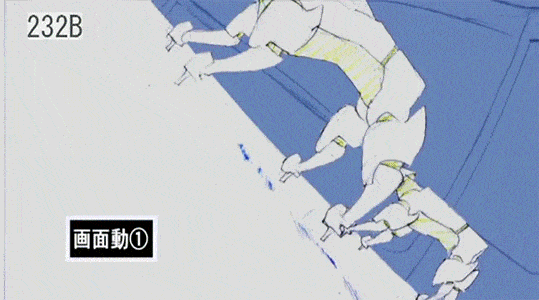
-Second Key Animation (第二原画/第2原画, Daini Genga ; 二原, Nigen):
The cleanup process required when the key animators’ output is too unpolished; includes tidying up the lines, finishing the drawings in case only the rough shapes were key'd, and leaving further references to guide the in-betweeners. Easily the least well documented animation role in the west, since its rise to popularity is still fairly recent. Over the last decade it has evolved from an unusual position to the absolute norm, and now pretty much every TV anime project features this credit every week. The only regular exceptions left are some long running kids shows (since the production cycle there isn't quite the same) and Kyoto Animation's series, once again making the studio a latenight anime anomaly; they did use to have the credit during the mid-00s, but it gradually disappeared from their TV shows as it was such a rare occurrence. You can still see some mostly younger animators do cleanup work in their shows now and then (credited slightly apart from the ‘regular’ key animators), but consistently lacking an entire post is yet another reason why their productions involve way less professionals than average. Sadly the studio is the exception that confirms the rule rather than the norm.
-In-betweens (動画, Douga):
In-betweening consists of filling the gaps left within the key animation sequences to fully create the illusion of fluid movement. The Japanese term simply translates to animation, which is very appropriate since it's not until the in-betweening process happens that a series of drawings actually becomes animation. This is done following guidelines left by the gengaman; in-betweeners are merely finishing someone else's job, so they're given strict notes to make sure the end result is what the key animators originally conceptualized. The timing chart (ツメ指示, tsumeshiji) they follow marks the spacing arc, effectively telling them where to draw the in-betweens – the closer a line is the less movement between two drawings there is. The same key drawings could become a front-loaded cut or a rear-heavy one depending on where the in-betweens are placed, and that has an obvious effect on the finished scene. If they are lucky, when working on complex or nuanced scenes they will also receive extra references such as how body parts are meant to move throughout the sequence.
The upcoming revolution in this field will be automatic tweening through tools like CACANI. A concept that has existed for a long time, and finally evolved to the point of being able to generate good (thus not noticeable) results in a controlled environment. Its widespread usage is still far away and it will still always require supervision, but recent fully digital 2D animation tests have been rather impressive. The consequences this will eventually have are massive, both positive and negative; in-betweeners have depressingly low wages even by this industry's standards, so theoretically there's much to gain by greatly reducing the demand for that role. On the other hand, it's also every animator's training grounds, where they learn by working on sequences crafted by more experienced coworkers. It's impossible to tell what would (will?) happen if the entry role pretty much disappeared, since many newbies definitely aren't ready for the standards that key animation requires. No one knows what will happen, but it's easy to understand why this will be a big deal.
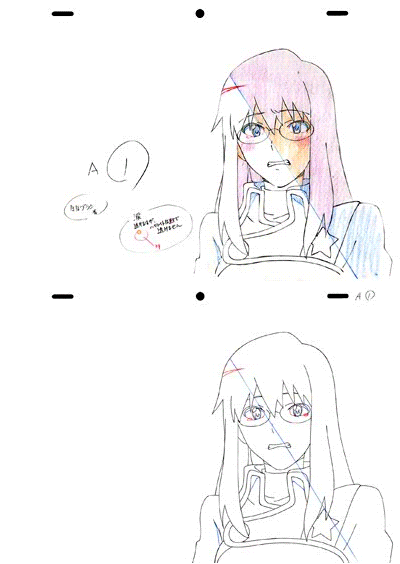
-In-betweens Check (動画検査, Douga Kensa):
The rough equivalent of animation directors when it comes to in-betweens, supervising the finished sequences and getting them fixed if there are any problems. Good in-betweening work will hardly ever elevate a cut - it's not a role with room for artistic freedom, it's restricted by the instructions and intent of the key animator, whose drawings already set the ceiling for the quality of the sequence. Doing a poor job however can ruin a scene in a multitude of ways; even excellent sequences are susceptible to be brought down by lacking or misplaced in-betweens screwing up its timing, and poor drawings can often cause issues as well – not so much because of the goofy frames than fans love to screencap (which tend to be harmless, animation is meant to work in motion after all), but rather because of flimsy linework causing the amusingly named Melting In-betweens phenomenon. Sloppy strokes, faces that fail to follow the key drawings and awkwardly make a character's factions jump around as they turn, this is something everyone has noticed at some point. Reducing the number of instances where such problems happen is why the In-betweens Check exists; while it's not infallible (I mean, what are you supposed to do when the drawings you were supposed to receive get stuck overseas?), this is by all means a step that anime benefits from.
This is the order in which all these people are credited (sometimes at least, not all shows display them in the exact same way), which obviously doesn't correspond to the chronological production timeline. Let's recapitulate then, to make it easier to understand: once the cuts have been assigned to each animator, layouts are drawn to fully realize the ideas from the storyboard into actual shots. Based on those the key animation sequences are drawn, and later cleaned up by 2nd Key Animators in case they were too rough and rushed. That's then sent to the animation directors, who will supervise the quality of the cuts and ensure that the drawings and timing of the animation are solid. After correcting what they see fit, the key animation is handed to the in-betweeners who trace it and complete the sequences, filling the gaps with new drawings that follow the instructions they were given. Once they're done, the In-Between Check takes place to make sure the finished animation sequence doesn't have glaring mistakes. That is the process to create one finished – albeit still in need of much work – cut of animation.
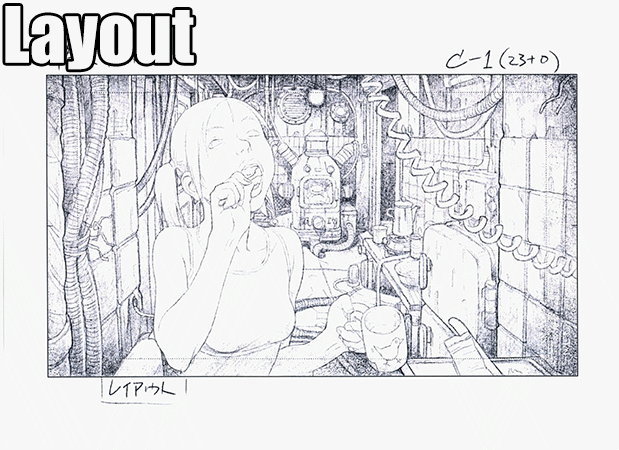
Producing even a single episode of TV anime takes months and entails many chores, and 1:30 minutes worth of scrolling credits is more than a single article can expand upon. That's why I'll be splitting them into smaller chunks, trying to group similar kinds of processes. The next set of terminology will consist of tasks to turn that finished but flavorless animation into functional footage – coloring, backgrounds, CG work and even digital postprocessing to give it a fancy coat of polish. Look forward to it!
discuss this in the forum (41 posts) |